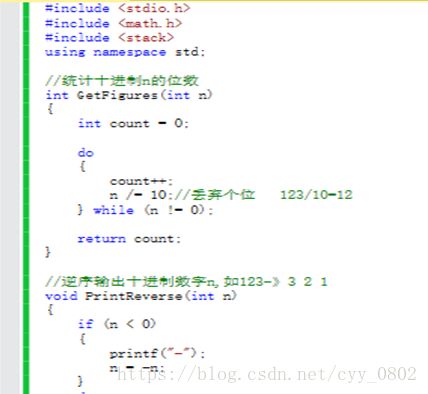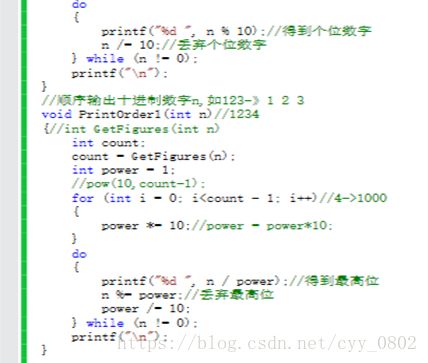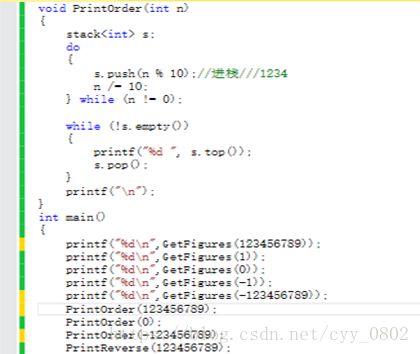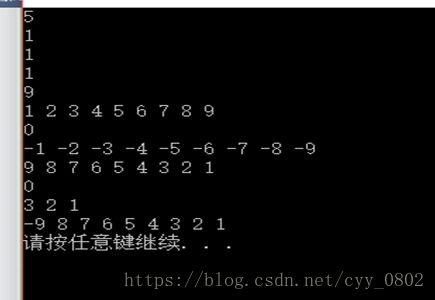给出不多于5位的正整数,求出它是几位数,分别输出每一位按逆序输出每一位数字。
给出不多于5位的正整数,要求:
1,求出它是几位数
2,分别输出每一位数
3,按逆序输出每一位数字,例如原数为321,应输出123.
第一种方法:
(1)求一个数是几位数,有一种方法是:
if (x > 9999)
{
place = 5;
printf("这是一个五位数\n");
}
else if (x > 999&&x < 9999)
{
place = 4;
printf("这是一个四位数\n");
}
else if (x > 99&&x < 999)
{
place = 3;
printf("这是一个三位数\n");
}
else if (x>9&&x<99)
{
place = 2;
printf("这是一个两位数\n");
}
else if (x > 0&&x < 9)
{
place = 1;
printf("这是一个一位数\n");
}
这种方法虽然简单,但是可利用性不强,如果判断的是N位数的数字,那么要写的else if(),就不是一两个了,所以实际应用中就不太合适。
(2)分别输出每一位数字,顺序输出十进制数字n,如123 -》1 2 3
myriabit = x / 10000;//万位
thousend = (x - myriabit * 10000) / 1000;//千位
hundred = (x - myriabit * 10000 - thousend * 1000) / 100; //百位
tendigit = (x - myriabit * 10000 - thousend * 1000 - hundred * 100) / 10;// 十位
unitsdigit = (x - myriabit * 10000 - thousend * 1000 - hundred * 100 - tendigit * 10) / 1;//个位
printf("(2)个位%d,十位%d,百位%d,千位%d,万位%d\n", unitsdigit, tendigit, hundred, thousend, myriabit);// 个位
(3)按逆序输出每一位数字,例如原数为321,应输出123.
switch(place)
{
case 1:printf("(3)逆序为:%d" , unitsdigit);break;
case 2:printf("(3)逆序为:%d%d" , unitsdigit , tendigit);break;
case 3:printf("(3)逆序为:%d%d%d" , unitsdigit , tendigit , hundred);break;
case 4:printf("(3)逆序为:%d%d%d%d" , unitsdigit , tendigit , hundred , thousend);break;
case 5:printf("(3)逆序为:%d%d%d%d%d" , unitsdigit , tendigit , hundred , thousend , myriabit);break;
}
另一种方法是:
(1)求一个数是几位数,:
丢弃个位 ,例如123,
123 / 10 = 12 n = 12 count =1;
12 / 10 = 1 n =1 count =2;
1 / 10 = 0 n= 0 count =3;
int GetFigures(int n)
{
int count = 0;
if(n / 10 != 0)
{
count++;
}
n /= 10;//丢弃个位
}
程序简单可利用性比上面的方法强很多,可以解决正数,负数但是0不可以。
如果要加上0,有两种解决方法:
1,在前面加上一个判断。
2,do
{
count++;
n /= 10;//丢弃个位
}while(n != 0);
(2)分别输出每一位数字,顺序输出十进制数字n,如123 -》1 2 3
void PrintOrder1(int n)
{
int count;
count = GetFigures(n);//函数调用
int power = 1;
//pow(10,count-1);
for(int i = 0; i < count - 1; i++)
{
power *= 10;//power = power * 10;
}
do
{
printf("%d ",n/power);//得到最高位
n %= power;//丢弃最高位
power /= 10;
}while(n!=0);
printf("\n");
}
还有利用栈的方法:
void PrintOrder(int n)
{
stack
do
{
s.push(n % 10);//进栈
n /= 10;
} while (n != 0);
while (!s.empty())
{
printf("%d ", s.top());
s.pop();
}
printf("\n");
}
(3)按逆序输出每一位数字,例如原数为321,应输出123.
void PrintReverse(int n)
{
if(n < 0)
{
printf("-");
n = -n;
}
do
{
printf("%d ",n%10);//得到个位数字
n /= 10;//丢弃个位数字
}while(n!=0);
printf("\n");
下面是程序的总代码,运行环境为Visual Studio 2013
运行结果如下图
(有各种情况的测试!负数的顺序输出若想只有第一位数带符号可以加上
if (n < 0)
{
printf("-");
n = -n;
}
)




